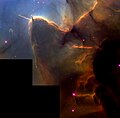Trifid Nebula
| Emission nebula | |
|---|---|
| Data of the Trifid Nebula
|
|

|
|
| Trifid Nebula, taken at the Palomar Observatory ; the area of the enlarged detail is shown. | |
| AladinLite | |
| Constellation | Sagittarius |
|
Position equinox : J2000.0 , epoch : J2000.0 |
|
| Right ascension | 18 h 02 m 42 s |
| declination | −22 ° 58 ′ 18 ″ |
| Appearance
|
|
| Apparent brightness (visual) | 6.3 mag |
| Apparent brightness (B-band) | 6.75 likes |
| Angular expansion | 28.0 ' |
| Ionizing source | |
| designation | HD 164492 |
| Type | star |
| Physical data
|
|
| Affiliation | Milky Way |
| Redshift | −0.000007 |
| Radial velocity | −2.13 km / s |
| distance | 5200 ly (1600 pc ) |
|
history
|
|
| discovery | Charles Messier |
| Date of discovery | June 5, 1764 |
| Catalog names | |
| M 20 • NGC 6514 • OCISM 2 | |
The Trifid Nebula (also known as Messier 20 or NGC 6514 ) is an emission and reflection nebula in the constellation Sagittarius . The name comes from the Latin word trifidus "three parts, three parts", because a dark cloud of dust ( Barnard 85 ) divides the fog into three parts .
Infrared image from the Spitzer Space Telescope
Detail of jets captured by the Hubble Space Telescope
The Trifid Nebula is a place of star formation ( H-II region ) with an apparent magnitude of +9.0 mag and an area of 28 '× 28'. The ionization takes place of the main mist through the hot star HD 164492, which is part of the 7-type. Inside the nebula, there are still some massive protostars that are only visible in the infrared. The distance of the Trifid Nebula from Earth is approximately 5200 light years. Because of its southerly position, the nebula is not particularly easy to observe in Central Europe. On the detailed image, jets can be seen as they develop during star formation .
See also
Web links
- Spitzer Observatory / M20
- ESO: Triple Trifid Nebula + Photos & Animation - Aug 26, 2009
- ESO: Interactive comparison image of the Trifid Nebula in visible and infrared light February 4, 2015



